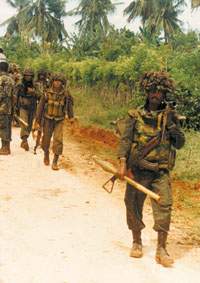| By
Paul Harris |
||||||
| Preserving
the State of Sri Lanka In any dynamic situation it is necessary to continually review strategy. Few situations are as dynamic as that pertaining in Sri Lanka: the 160 days since the signing of the ceasefire agreement have seen significant changes in balance of power and influence on the ground in the north and east of the country.
In the interests
of long term stability for the country as a whole, it seems to me
that strategy requires to be radically adapted in recognition of
the facts of life on the ground. My suggested
new strategy is based on military/defence requirements in the context
of preserving the integrity of the state so far as is possible given
the present situation. I recognise that some of my suggestions would
be difficult to implement politically, but they are based entirely
on a pragmatic approach without reference to political agendas of
any party. As such, they
may be impractical but are presented as a compromise solution to
demarcate the country whilst that option is still available to the
government in Colombo. During the
last 160 days it is, I think, fair to say that the government has
done everything in its power to promote a lasting peace. It might
very well be argued that the government has done far too much and
there have, indeed, been remarkable concessions made to the LTTE.
As a result
of the ceasefire agreement, the power and influence of the LTTE
in the so-called 'cleared' areas of the north and east has increased
enormously: those in rebellion against the legitimate state apparatus
have effectively achieved more in five months or so than in the
last five years. There is an
early prospect of parallel court, police and taxation systems throughout
the north and the east as the LTTE effectively occupies all the
social and political space. A de facto state of Tamil Eelam is now
inevitable and strategy should now be adjusted to limit the borders
of this nascent state whilst a military capacity, albeit demoralised
and degraded, still exists. It seems to
me that in military-strategic terms there is no justification any
longer for maintaining almost 40,000 members of the security forces
in the Jaffna Peninsula. Their work is effectively over: the uncleared
areas of the Wanni can never be retaken and a disproportionately
large number of the limited security personnel available to the
country are holed up in a tiny, indefensible piece of land with
no apparent future military objective. They should
be withdrawn by air and by sea as quickly as possible and redeployed
to the east where they will be able to assure the security of Muslims
and others who dissent from the LTTE's aggressive policy of taxation
and coercion. An adequate force of police might be left for the
present - and there should be the option for evacuation of civilians
who have cooperated with the security forces - but, in the longer
term, the Jaffna Peninsula will be required to be abandoned to the
LTTE, together will all other lands north of Vavuniya. The present
forward defence line (FDL) could come to represent the border of
a future, independent Tamil Eelam and it will be both more defensible
militarily and politically acceptable to the state of Sri Lanka
than a long meandering border curling around from Chilaw to Hambantota.
Such a border
will imply decades of sporadic, inconclusive Palestinian-style conflict.
If the LTTE fails to make itself available for talks at an early
stage then contractors should be engaged to reinforce the FDL in
the north with an electronic chain-link fence, reinforced by minefields,
razor wire, bastion walling, and ditch emplacements, on the Sri
Lanka Army side. Israeli contractors
are well versed in construction of this type of semi-permanent defence
capability. This will not only serve to create a defensible FDL,
but will also separate LTTE cadres in north and east with associated
military benefit to the state. There will then be sufficient security
for the people of the east to vote freely and without inhibition
in a referendum as to whether they wish to live under the LTTE or
within the democratically organised Sri Lankan state. If, as would
seem likely, the people of the east vote for their own democratic
federally-based local government, then the remaining LTTE cadres
in the east can be offered voluntary repatriation over the northern
FDL, or they can be surrounded and eradicated. Failure to
adapt strategy at this stage will, in the short term, see the LTTE
becoming increasingly bold in its demands. Today, it is demanding
that coastal waters off the east of the country be regarded as the
preserve of the Sea Tigers and is seeking exclusion of the Sri Lanka
Navy. The next demand
will be for the removal of land-based security forces. In the medium
term, there will be severe effects on the 300,000 strong Muslim
population of the east and on isolated pockets of Sinhala farmers
in the north and the east. At best, they will find it disagreeable
to stay on in a mono-ethnic, undemocratic state. At worst they
face ethnic cleansing. In the longer term, absence of new strategy
will place much of the hill country under threat of absorption by
Tamil Eelam. There is considerable evidence mounting that the LTTE has clearly defined long term goals in this area and the threat should not be taken lightly. Its ultimate absorption within Tamil Eelam would imply economic doom for the state of Sri Lanka. |
||||||
Copyright © 2001 Wijeya Newspapers
Ltd. All rights reserved. |
